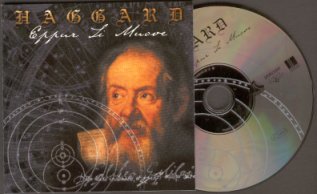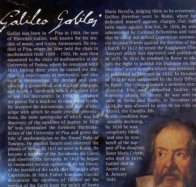
All'Inizio e' la Morte
Menuetto in Fa minore
Per Apera ad Astra
Of a might Divine
Gavotta in Si-minore
Herr Mannelig
The Observer
Eppur si muove
Larghetto/Epilogo Adagio
Herr
Mannelig (short version)
|
Asis Nasseri Luz Marsen Robin Fischer Andi Hemberger Gaby Koss Judith Steffi Hertz Kathrin Hertz Veronika Fiffi Fuhrmann Hans Wolf Ivica Michi Stapf Florian Bartl Mark Michael Schumm Andi Peschke |

review by Marco "Norman
Knight" Signore____ ![]()
Well,
the review of such an opera of classical music mixed up with metal is
not easy at all. Haggard, however, are truly a particular phenomenon of
the metal world, in the fact that they compose music paying attention
both to the metal side and to the string sections they posses.
 This
“Eppur si muove”, dedicated to the famous Italian scientist Galileo
Galilei, is no exception in the Haggard production hitherto, and so we
must be prepared to listen not only to Metal but to pure Classical music
as well. I will try to translate also the Italian titles in
English…so to give a better picture of the album.
This
“Eppur si muove”, dedicated to the famous Italian scientist Galileo
Galilei, is no exception in the Haggard production hitherto, and so we
must be prepared to listen not only to Metal but to pure Classical music
as well. I will try to translate also the Italian titles in
English…so to give a better picture of the album.
The
cd opens with a Latin choir on a very interesting piece of adagio
underlined by viola and wind instruments and spotted by a delicate,
never invasive drum. This Reinassance piece is suddenly broken by the
harsh voice that in pure German tells us of the beginning of this great
work of music, accompanied this time also by a delicate classical guitar
sound. The voice creates a bitter contrast between its cadenced
harshness (mixed with German and Eglish lyrics) and the sweed and
intricate melody of the classical instruments underneath.
Suddenly a vocalizing soprano voice introduces us to the “metal”
section of this song (titled “Adesso è la Morte”, Now is
Death), where classical strings and winds mingle with bass, guitar and
drums that underline a symphonic metal rhythm (very similar to the
Therion of the last albums). The quasi-growl voice
gives almost an impression of Black metal to the song, as it fades away
on the dreaming notes of a flute and a cello with the violins bringing
the full brunt of the melody and the soprano voice embroiders on the
growling male voice, and all comes to an end ina mix of Latin and German
with final crescendo notes of organ. An impressive piece, nothing
to say!
We
have a moment of rest with the Menuetto in Fa
Minore (Minuet in F minor), and we follow the title of
the next song… Per Aspera ad Astra
(roughly “through difficult roads to the stars”) to
discover the rising of the star of Galilei, and a new way of scientific
thinking… as the song rises like the sun in a new dawn to get to a
driving movement of drums, bass and violins, with the coutnerpoint of
growl and soprano voices that fade out in a wind and a violin with a
cadenced bass drum… then a tamburella
leads again to the Metal/Reinassance music in a sequence of dreaming
images evoked by this exceptional music as Galilei discovers the four
Satellites of Jupiter and the song becomes a true Metal one.
next song… Per Aspera ad Astra
(roughly “through difficult roads to the stars”) to
discover the rising of the star of Galilei, and a new way of scientific
thinking… as the song rises like the sun in a new dawn to get to a
driving movement of drums, bass and violins, with the coutnerpoint of
growl and soprano voices that fade out in a wind and a violin with a
cadenced bass drum… then a tamburella
leads again to the Metal/Reinassance music in a sequence of dreaming
images evoked by this exceptional music as Galilei discovers the four
Satellites of Jupiter and the song becomes a true Metal one.
Another
piece played with sounds and sonorities typical of the Reinassance is
then introduced to our wondering ears… it is called Of
a Might Divine. After a very Reinassance like introduction,
we find the melancholic sound of a piano counterpointed by a contrabasso
(or very low viola) and then the violin enter to create another adagio
to lead us to the narrative lyrics sung by a beautiful male voice again
in counterpoint with a soprano… and then an arpeggio of harpsichord
starts a growl-voiced metal part. The Church and
the Inquisition have come for Galileo… he will soon revoke his
teachings… or will burn at the stake. The atmosphere once again is
perfectly given by this song, that ends in the adagio that started it.
A
gavotte, Gavotta in Si minore (in B
minor) then leads us to another part of this opera
magna, this time a popular Scandinavian song
titled Herr Mannelig and proposed in this album in a long
and a short version (thanks Dalia for the information!!), and
sung by the soprano voice in perfect Italian (much better than some
Italian singers that distorce their language to conform to the
English accent…). But those of you that expect a “typical” Reinassance
popular song will be astonished by the orchestration of this piece: a
true masterpiece, that begins with an ominous bass drum and pipes (it
remembered me of Biko by Peter Gabriel, to be honest) and then becomes
almost a power metal mid tempo.
The
Observer, the next song in this beautiful opera, begins with
a nice piece of harpsichord and a whispered voice that fades into a mid
tempo with strings that create the mood for the
voice in growl to tell us of the discoveries made by the great Galilei;
this is the most “Metal” song in the disc, with marked
changes of tempo and remarkable drum’n’bass work.
And
we come to the Title Track of the album: Eppur
si Muove (“and yet it is moving”), introduced by a
delicate piece of classical instruments – they stop, and the soprano
voice remains alone, in a sort of cold, dark environment, and the
silence is then broken by the notes of a piano that grow like more
streams bring water to a river – resolving the arpeggio chords with
harmonic solutions non unlie the typical Reinassance music. And
here you have drums and celloes and strings to create the carpet of
sound for the growl voice as the rhythm increases its pace and ferocity
to become a fast tempo, stopped here and there when the soprano enters
the fray and duels with the growl voice. The
powerful drums suddenly change tempo again… “... e nella mia ora più buia loro splenderanno per me all’infinito…”.
A
new harmonic section, this time again going back through the centuries
with cymbals, tambourine and flute carries us towards the end of the
song with a vocal line in German and then in Italian (always in pure
growl). Again then the drums start and the vocals bid us farewell
remembering us that the stars will shine forever, religious blindness
and ignorance nonwithstanding. An adagio of piano, wind and string
instruments salute the listener, giving to this finale a dramatic, sad
tone… almost as the players of a tragedy leave the stage one by one in
silence, knowing all too well that due to their acts history has been
changed, but they will not play their part in it anymore.
The
album ends with another pearl: a short version of Herr Mannelig.
Dreaming, dark and oniric, this version differs only in the duration
(about 3.19 minutes against the 4.30 of the track 6) – but there is a
surprise… a ghost track of about 55 seconds, a splendid piece of flute
and piano, made by arpeggios and counterpoint, really beautiful… a
precious small gem at the top of a magnificent crown!
This
album is a touch of genius. Maybe it will meet the same problems that
Galilei met in his time… the kind of music is quite strange indeed,
mixing classical, death metal, lyrical, and symphonic music; and the
choice of using Reinassance instruments, and not samplers or synths
makes this album extremely beautiful and yet not palatable by everyone.
The harsh, growled vocal line will be hard to listen to because it is in
marked, hard contrast with the delicate classical instruments music –
except when the drum and bass and the distorted guitars remember us that
we are listening to a heavy metal band. But what a band! Haggard managed
to combine classical music with Dark and Heavy metal in a way that few
others manage to. In my humble opinion, then,
Haggard have made a true masterpiece, but this masterpiece will not be
for everyone – it is hard to digest and hard to listen to, unless your
ear is really opened to new forms of music. Therefore
if you like Haggard and their genre, this disc it is absolutely a must;
but if you are more used to other, smoother forms of metal, then you may
find this album a bit hard to tackle. Nonetheless, you should at least
listen to it once!
Rating: 8.5/10
[ Presentation ] [ News ] [ Reviews ] [ Interviews ] [ Live Reports ] [ Specials ] [ F**king Bollox ] [ Tours ] [ Dates ]
[ In Store ] [ Upcoming Releases ] [ Underground] [ Artwork ] [ Videoclips ] [ MP3's ] [ Venues ] [ CD's Archive ]
[ Links ] [ Contacts ] [ Gryphonbook ]